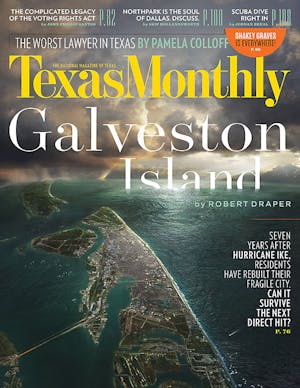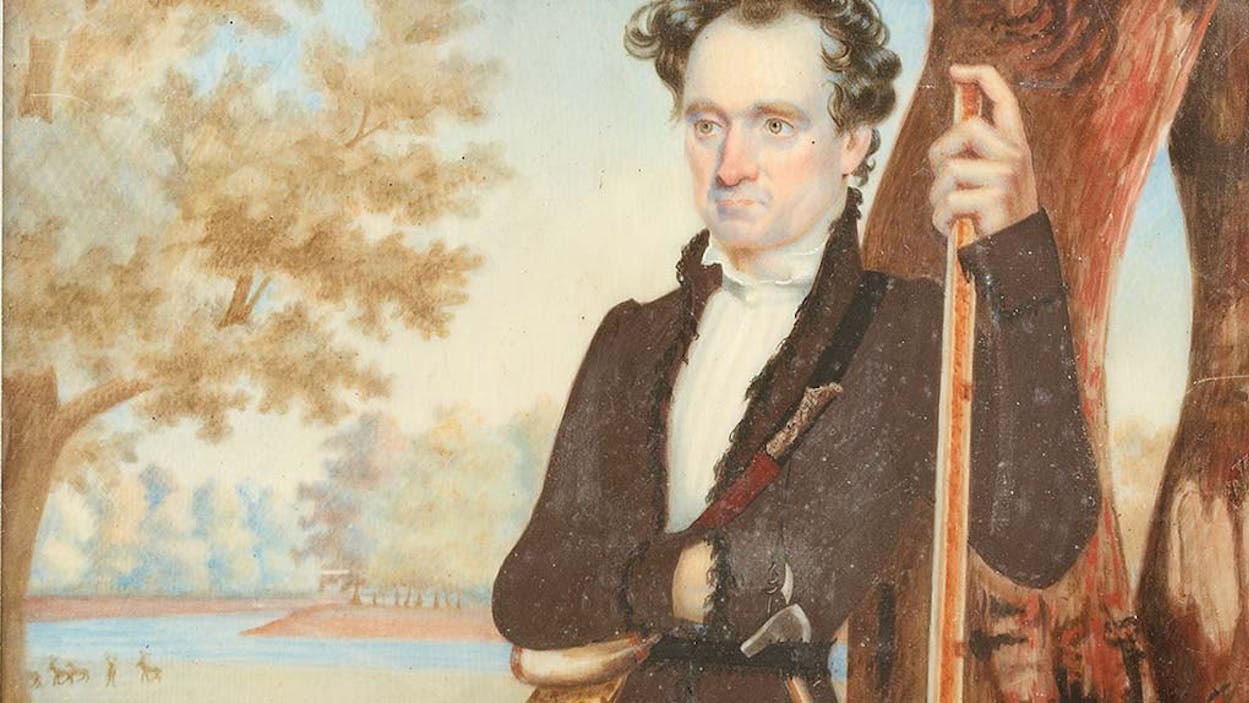Of all the founding fathers of Texas, Stephen F. Austin seems the most remote. It is easy to imagine having a drink with Sam Houston, trading stories with Davy Crockett, or backing up Jim Bowie in a fight, but a convivial evening at Austin’s dining table is hard to imagine. He has come down to us as an austere and reserved figure.
Perhaps he intended it to be that way. Born in Virginia in 1793, he was carefully groomed by his wealthy father to achieve “greatness in life,” as Moses Austin put it in a letter he wrote to Stephen when he was eleven years old. He exhorted his son to be particular in deportment, dress, and choice of companions. When he was eighteen and setting out in the world of business, his father gave him detailed advice about how to conduct himself, telling him that “a young man must always remember that his appearance is greatly noticed by strangers” and explaining to him that the style of dress that was acceptable in New Orleans was not appropriate in Philadelphia or other northeastern cities. He went on to advise him to, when dining out, “always inform yourself of the rules of the table and conform to them.” Otherwise, his father concluded, he might be thought “deficient in breeding.” Moses wanted to equip his son to succeed him as a prosperous businessman, community leader, and head and protector of a large family of relatives and dependents.
Austin filled those roles by becoming a master of self-presentation and self-control. The naturalist Henry Schoolcraft, who met him in 1818, described him as a “gentleman of an acute and cultivated mind, and great suavity of manners.” His nephew, Moses Austin Bryan, said that “with others he had such ways as to make everyone like and be easy with him” and added that “his voice was manly and soft, his colloquial powers fluent, persuasive, and attractive, without his being conscious of it himself; his magnetic power over others gave him the great influence he possessed.”
In 1821 Moses died, and his son inherited his contract to colonize Texas. That summer, during his first trip to Texas, he charmed Governor Antonio Martínez, who went to great lengths to be helpful in spite of the fact that Mexico’s independence from Spain had jeopardized his own position. When Austin went to Mexico City to have his father’s contract confirmed, he cultivated friendships with such highly placed figures as José Manuel de Herrera, the minister of domestic and foreign relations; Anastasio Bustamante, the commandant general of the Eastern Interior Provinces; and Lorenzo de Zavala, a key member of the Mexican Congress’s colonization committee. Austin learned Spanish in order to converse agreeably with them. When he left Mexico City a year later with his contract confirmed and his “great enterprise” of settling Texas with Anglo-Americans launched, he had gained the confidence of a clutch of powerful officials.
Austin retained that confidence during the first decade of his colony’s existence. He urged his colonists to maintain their fidelity to Mexico by conforming to its laws and customs and by disassociating themselves with any attempt by other empresarios to resist the decrees of the Mexican government. Dealing with the Anglo-American frontiersmen required the same degree of tact and diplomacy that Austin employed in his relations with Mexican officials. He strove to maintain a dignified distance from them to preserve his authority while at the same time taking care not to offend their democratic sensibilities. When he was contemplating bringing his mother and widowed sister to join him in Texas, he wrote to them saying that if they came they would have to wear homespun clothes because “it will set an example to the rest of the Settlers that will have a very good effect,” explaining that “the situation I am placed in here will cause all the acts of any of my family to be observed and it will require a uniform affable deportment to all without regarding their appearance or poverty to prevent giving offences.”
Austin presented an aloof face to others, sometimes disguising his motives. A clue to how he saw himself lies in a portrait that he commissioned by an English artist named William Howard when he was in Mexico City in the fall of 1833. The portrait, a five-by-five-and-a-half-inch watercolor on ivory, depicts Austin in a fringed buckskin hunting coat, his left hand on the barrel of a Kentucky rifle and his right inserted into his coat just above a tomahawk in his belt. He is standing with his back to a tree, and a hunting dog is to his right. Despite his political connections, Austin was arrested in 1834 on suspicion of inciting rebellion, but before he was imprisoned in Mexico City, he was able to send the portrait to his brother-in-law, James F. Perry, in Texas. It now resides at the Briscoe Center for American History, on the campus of the University of Texas at Austin.
Howard’s portrait is almost an exact copy of Chester Harding’s 1820 portrait of Daniel Boone, which shows Boone standing in front of a tree, holding a Kentucky rifle, with a dog on his right. In spite of his declarations of loyalty to Mexico, Austin evidently saw himself as a Daniel Boone, expanding America’s frontiers by leading settlers into a new wilderness.
Briscoe Center for American History, 2300 Red River, Austin (512-495-4518). Open Mon–Fri 10–5, Sat 9–2 (call ahead for exceptions).







